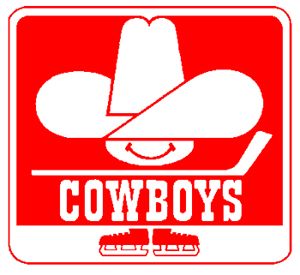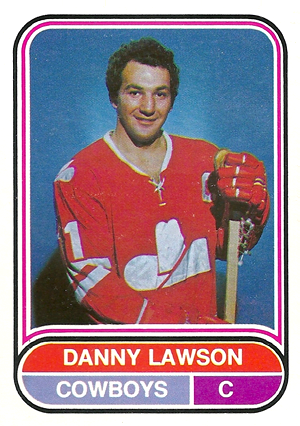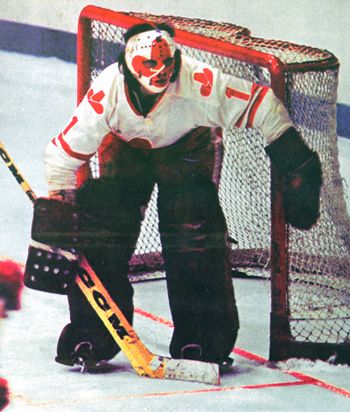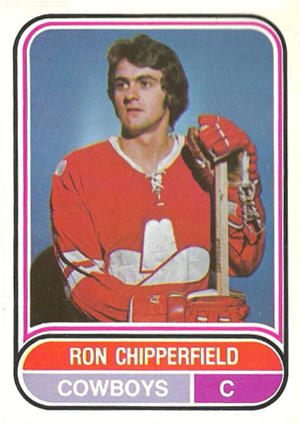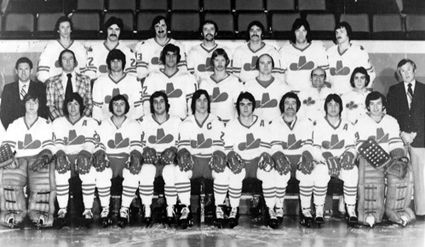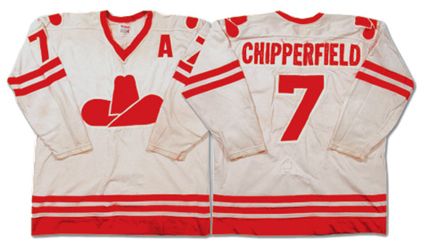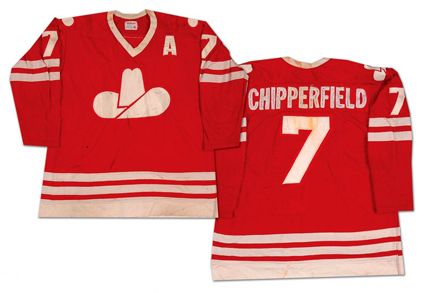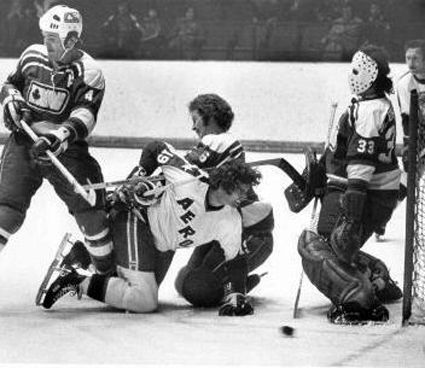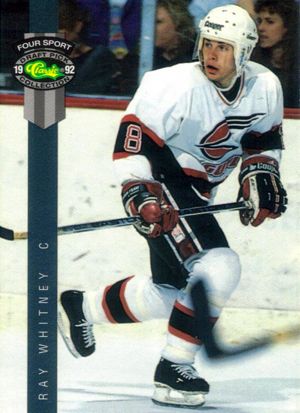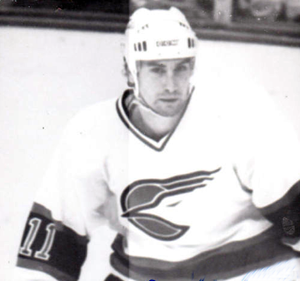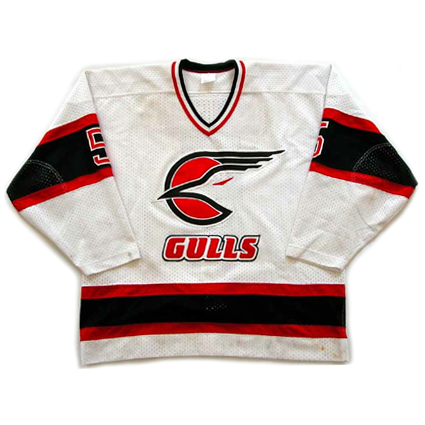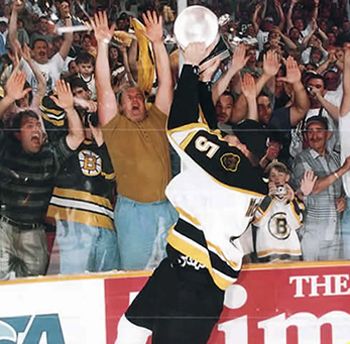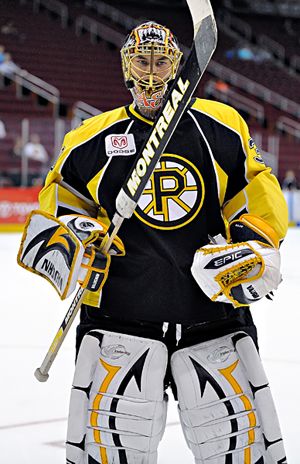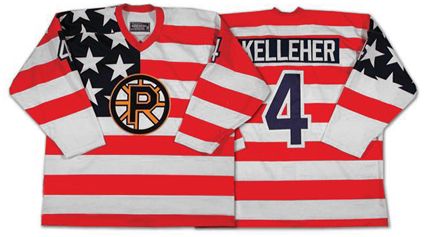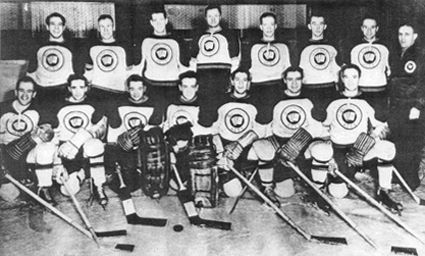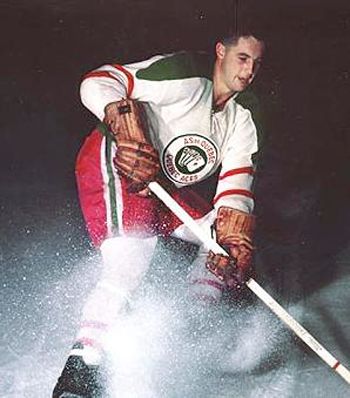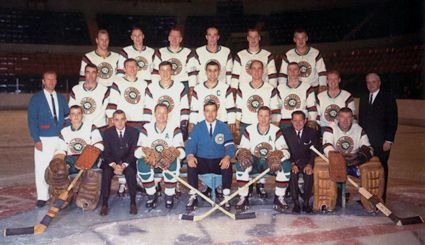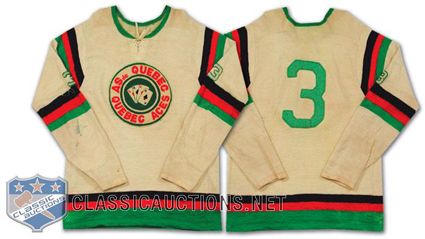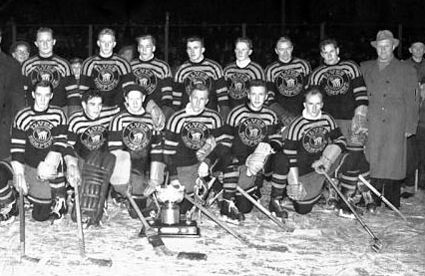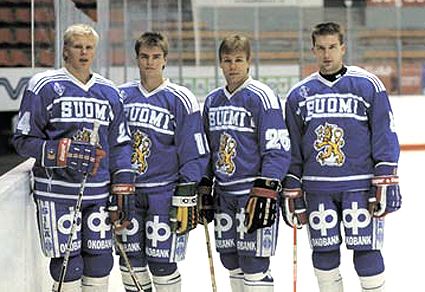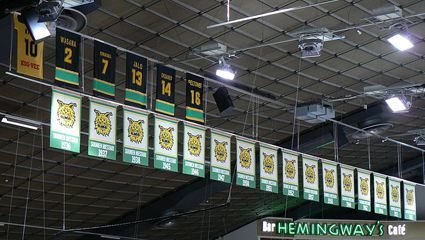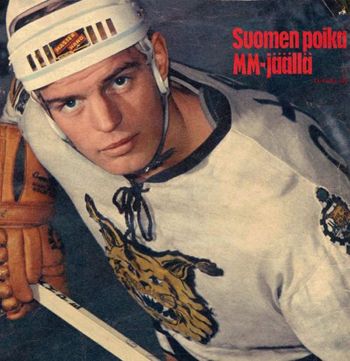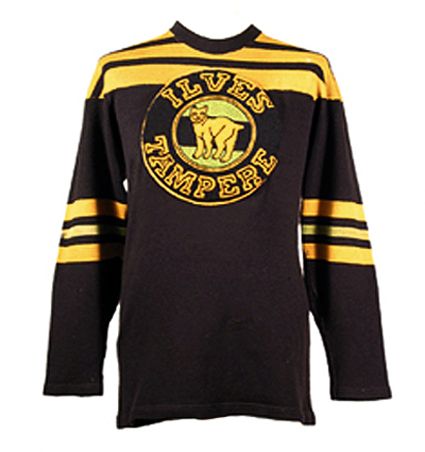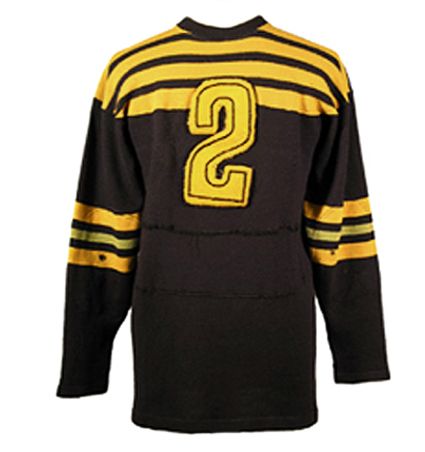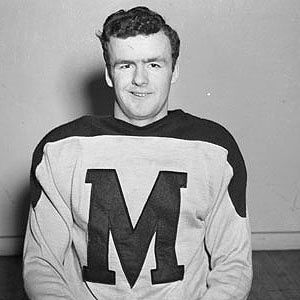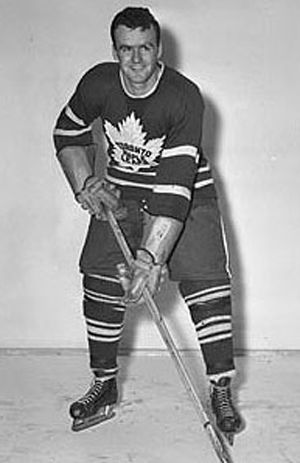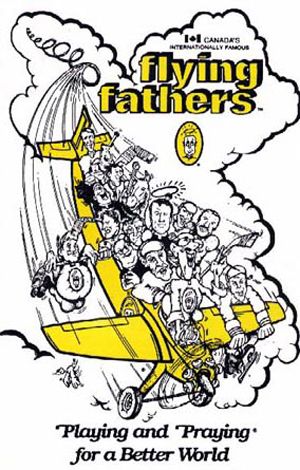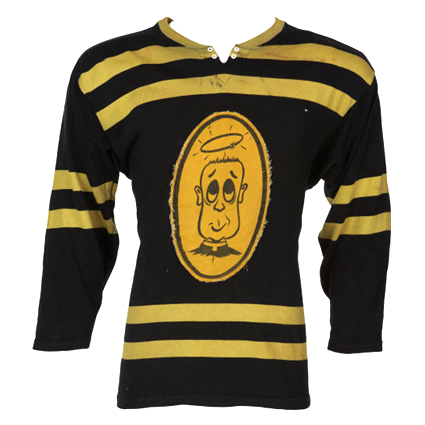photos courtesy of Classic Auctions
Saturday, July 7, 2012
1975-76 Calgary Cowboys Ron Chipperfield Jersey
July by the Numbers remains in the World Hockey Associaton for jersey #7.
The WHA franchise originally slated to be the Miami Screaming Eagles was foiled by a lack of finances and a suitable arena which silenced that plan and the team participated in the inaugural WHA season as the Philadelphia Blazers. After just one season, the team packed it's bags and moved all the way to the west coast, becoming the Vancouver Blazers.
After two seasons of being unable to compete with the NHL's Vancouver Canucks, the franchise was moved yet again, this time to Calgary, where they became the Calgary Cowboys.
The WHA had originally hoped to place a team in Calgary back in 1972 as a rival to the Edmonton Oilers, but that plan never came to be. When Blazers team owner Jim Pattison chose to relocate his last place team to Calgary, the WHA was already having difficulties with instability, evidenced by two franchises folding in the middle of the Cowboys first season in Calgary, which hurt their image as a major league product.
The team was housed in the 6,500 seat Stampede Corral with the hopes that strong attendance would encourage the the Calgary Exhibition and Stampede board to expand the seating to a size which would allow the club to be profitable, something not possible with the Corral's current small size.
The Stampede Corral
Led by Danny Lawson and Ron Chipperfield, the team surprised many with a 41-35-4 record. Lawson led the club in scoring with 44 goals and 96 points while Chipperfield followed with 42 goals and 83 points, the only two to surpass 60 points.
Butch Deadmarsh added 26 goals while George Morrision, Rick Sentes and Don Tannahill all added 25 goals to the cause while the goaltending was handled by Don McLeod, who played in 63 of the Cowboys 80 games.
Despite the small arena, they team still did not play to capacity, averaging a dismal 4,948 fans, next to last in the league by 1,200 fans and one of only two teams under 5,000, the other being the troubled Denver Spurs/Ottawa Civics franchise which did not even survive the season.
The Cowboys entered the playoffs as underdogs to the Quebec Nordiques, who finished 18 points ahead of them in the standings, but Calgary won the first two games on the road in Quebec on their way to a 4-1 series win, which included a legendary brawl that cleared both benches and lasted 20 minutes before the teams were escorted to their locker rooms by the Quebec police! Eventually, Calgary's Rick Jodzio, who started the melee by cross checking the Nordiques Marc Tardif in the head, pleaded guilty in a Quebec court to a charge of assault and the Cowboy's coach Joe Crozier was suspended for the rest of the series over the incident.
Having moved on to the next round, the Cowboys were eliminated in five games by the eventual champion Winnipeg Jets.
For the Cowboys second season, Lynn Powis stepped up with a 30 goal, 30 assist season to lead the club with 60 points. Warren Miller (55), Chipperfiled (54) and Peter Driscoll (52) all chipped in over 50 points. McLeod once again held down the duties in goal, playing in 66 games.
Unfortunately, the team slipped in the standings, winning 31 while losing 43 and tying 7 which resulted in them earning 69 points, missing out on the postseason by 3 points to the Oilers.
The 1976-77 Calgary Cowboys
Attendance sagged to 4,313, by far the lowest in the league. Think about that for a moment. A professional hockey team in Alberta, Canada not only finished last in the 12 team league, but they were 1,700 below a team in San Diego, California and 4,100 per game down to a club in Birmingham, Alabama and their attendance was doubled by a team in Houston, Texas.
Clearly it was a situation that could not continue, and there were rumors of the team relocating to Ottawa, which had already failed fours years earlier, causing the league to veto the plan. In a familiar refrain, Pattison hoped to keep the team going long enough to be part of a deal to join the NHL, but the NHL made it clear they had no interest in having a team play in the Stampede Corral. With just 2,000 season tickets sold for 1977-78 and no hope for a new arena and not enough time to find a new city to play in, Pattison chose to fold the franchise in August of 1977, bringing to an end the Cowboys after just two seasons.
Today's featured jersey is a 1975-76 Calgary Cowboys Ron Chipperfield jersey as worn during the Cowboys first season in Calgary after the franchise, originally destined for Miami, had played one season in Philadelphia and two in Vancouver.
The team's cartoon logo of a smiling cowboy with a stick and skates was overly simplified to just his hat for the main logo on the team's jerseys, which were a simple, attractive red and white design with multiple stripes, with the red likely chosen to contrast with their hoped rival, the Oilers blue. Had the club survived, the very 1970's smiley face logo would have become dated very quickly and would have been in need of a replacement in short order.
Today's bonus jersey is a 1976-77 Calgary Cowboys Ron Chipperfield jersey as worn on the road during the Cowboys second and final season in Calgary.
Today's video is brief footage of the infamous playoff brawl between the Cowboys and Nordiques, started when Jodzio crosschecked Quebec's Tardif with commentary by Tardif and others in French that we only wish we could understand.
Labels:
Calgary Cowboys
Friday, July 6, 2012
1972-73 Ottawa Nationals Brian GIbbons Jersey
July by the Numbers once again crosses the continent for jersey #6.
When plans began to take place for the inaugural season of the World Hockey Association in 1972-73, the league naturally wanted to have a club located in Toronto, but they ran into a road block of the most stubborn kind in the form of Harold Ballard, the cantankerous owner of the Toronto Maple Leafs and, more importantly, their arena, Maple Leaf Gardens.
When no deal was able to be reached with Ballard, the franchise earmarked for Toronto was instead placed in the capital of Ottawa after an attempt to locate the club in Hamilton. The Nationals failed to lure any top-flight NHL talent to Ottawa, such as Brad Park, Dave Keon or Eddie Shack, all of whom were on their draft list, due to their late start in finding a home, but Wayne Carlton was signed away from the California Golden Seals, one of several players the Seals lost to the upstart WHA, and led the club with 42 goals and 91 points.
The Nationals leading scorer Wayne Carlton
The goaltending duties where handled by rookie Gilles Gratton, who was backed up by former Pittsburgh Penguin veteran Les Binkley. Gavin Kirk and Bob Charlebois each scored more than 60 points while Brian Gibbons led all defensemen in scoring with 42 points while Rick Cunningham led the team with 121 penalty minutes.
Gilles Gratton guards the Nationals goal
After losing their first three games, the Nationals won their next four. They spent their first three months hovering around the .500 mark, closing out December with a 16-18-3 record, which included a pair of four game winning streaks.
January was unkind to the Nationals, who dropped 11 out of 14 to fall to 19-29-3. After going 6-7-1 in February, the Nationals caught fire and roared through March with a spectacular run, winning 11 of 12 to force themselves back into the playoffs, with their 74 points edging the Quebec Nordiques at 71.
Despite Ottawa not having had top level professional hockey since the once-dominant Ottawa Senators left the capital in 1934, attendance proved to be an issue, as the team drew an average of just 3,226 fans per game in the 9,000 seat Ottawa Civic Centre while competing with the established and quite popular Ottawa 67's junior club of the Ontario Hockey Association.
The Nationals were paired with the first place New England Whalers in the opening round of the post season, however...
...the City of Ottawa demanded a payment of $100,000 to secure dates for the following season prior to the playoffs, which prompted the club's ownership to consider their options which resulted in them choosing to move all their "home" playoff games to Toronto!
Now known as the Ontario Nationals during the playoffs, they lost their first two games 6-3 and 4-3 in Boston. The Nationals returned "home" to face the New England Whalers and won Game 3 by a score of 4-2, but lost Game 4 by a decisive 7-3 score while averaging 5,000 fans a game. The Whalers closed out the series with a 5-4 win back in Boston to end the Nationals season, and as it turned out, the Nationals themselves, as the team was sold following the season to John Bassett, who made Toronto their permanent home and renamed the team the Toronto Toros in June of 1973.
Today's featured jersey is a 1972-73 Ottawa Nationals Brian Gibbons jersey as worn during the Nationals only season in Ottawa. This is a very attractive jersey for it's day and the addition of the extra blue stripe trimmed in white just under the shoulder yoke makes it very unique. We especially like the white name on the red nameplate placed directly on top of that stripe.
The team logo is also very bold and well executed, although we always felt it looked more like a corporate logo, for a railroad in particular, rather than a pro hockey team.
Still, a very nice jersey and one that lived an all too short life.
Here is a history of the formation of the WHA and some of the first players to join the upstart league.
Labels:
Ottawa Nationals,
WHA
Thursday, July 5, 2012
1990-91 San Diego Gulls Peter Dineen Jersey
July by the Numbers crosses the United States for a stop in sunny San Diego, California for jersey #5.
The name San Diego Gulls dates back to the original Gulls franchise, which played in the Western Hockey League from 1966 to 1974. That franchise met it's demise with the arrival of the San Diego Mariners of the World Hockey Association, but the Mariners lasted just three seasons before folding, one of many teams to fall by the wayside in the unstable WHA.
Professional hockey would return to San Diego in 1990 when the International Hockey League would grant the city an expansion franchise, which would revive the name San Diego Gulls.
The team was reasonably competitive their first season with a 30-45-8 record, but missed out on the playoffs.
Russian import Dmitri Kvartalnov arrived for the Gulls second season and helped ignite their offense, which scored 67 goals more than the previous season, led by Kvartalnov's league leading 118 points. His 60 goals also led the IHL and were 16 more than his next closest pursuer.
IHL scoring champion Dmitri Kvartalnov
The Gulls roster also boasted future NHLer Ray Whitney, former New York Ranger Ron Duguay and Wayne Gretzky's brother Keith Gretzky and were led in goal by IHL veteran Rick Knickle.
Ray Whitney
The boost in offense resulted in a reversal of their record, finishing the season 45-28-9, a 31 point improvement.
With Kvartalnov off to join the Boston Bruins, the Gulls no longer had the flashy high scorer they enjoyed the previous season, but they roster was also no longer so top heavy in scoring. Their more balanced attack was led by Daniel Shank's 39 goals and 92 points, which placed him 5th in the league. Former Winnipeg Jet and Buffalo Sabre Scott Arniel was second with 35 goals and 83 points, one of six Gulls with over 70 points, compared to three the year before. Knickle again led the way in goal with 33 wins in 41 appearances as the Gulls soared to a league best 62 wins and 132 points, setting not only IHL records, but professional records as well, tying the 132 points by the 1976-77 Montreal Canadiens and holding the victory record outright until it was tied by the 1995-96 Detroit Red Wings.
The club started the season by going 26 games before losing in regulation for the first time and had winning streaks of 8, 9, 11 and 12 games and never lost more than 2 in a row all season under head coach Rick Dudley. The Gulls were able to load their roster with veteran and experienced players since they were not affiliated with any NHL club eager to have their young prospects developing in the minors. Starting the season with five players who had at least 10 seasons of NHL experience, the club was so dominant that the other IHL owners banded together and passed a rule which required teams to have at least six players with less than three years of professional experience.
As expected, the Gulls swept the Peoria Rivermen and ousted the Kansas City Blades in six to reach the Turner Cup Finals for the only time in their history, but were unceremoniously swept by the Fort Wayne Komets, scoring just 5 goals while giving up a massive 21.
Scott Arneil
The Gulls came back down to earth in 1993-94, winning 42 games while now being coached by former NHLer Harold Snepsts, their fourth coach in four seasons. Lonnie Loach led the club in scoring with 42 goals and 91 points from 74 games, as he also played three games with the Mighty Ducks of Anaheim that season. The Las Vegas Thunder fell in five games to the Gulls, but they in turn were swept by the Atlanta Knights to put an end to their season.
They slipped to a 37-36-8 record in 1995-96 with Hubie McDonough leading the way with 43 goals and 98 points, 6th in the IHL. Allan Bester led the goaltenders with 58 appearances, winning 28, while four other goalies combined to win less than 10. Despite being up 2 games to 1, the Gulls lost the final two games of their best-of-five series, which proved to be the final games for the Gulls.
After finishing third in league attendance in 1992-93 with an average of 7,728, and over 7,100 the following season, the Gulls dropped to 4,660 during their final season as the franchise was then relocated two hours up the coast to Long Beach where they were renamed the Ice Dogs.
Today's featured jersey is a 1990-91 San Diego Gulls Peter Dineen jersey. While the Gulls only lasted five seasons, they left behind a legacy of a striking logo and attractive jerseys of red and black.
Today's video section is some good old IHL hockey from the mid-1990's with fists and mullets as the Gulls and Houston Aeros engage is a battle, which includes current Minnesota Wild head coach Mike Yeo, #8 for the Aeros.
Labels:
San Diego Gulls
Wednesday, July 4, 2012
2001-02 Providence Bruins Chris Kelleher Jersey
July by the Numbers finds it's way to Rhode Island today for jersey #4, a fitting style for Independence Day in the United States.
After the Providence Reds left town after 51 years of play, the city would have to wait 15 years for the arrival of it's next club, the Providence Bruins, who were previously known as the Maine Mariners from 1987 to 1992.
The Bruins won their division in 1992-93, their first season in Providence, with a 46-32-2 record and were led in scoring by future Boston Bruin Tim Sweeney, whose 41 goals and 96 points placed him 8th in the AHL scoring race.
It would take until 1998-99 for Providence to win another division championship, which they did in style with a league best 56-16-4 mark, this after winning just 19 games the previous season! The Bruins were led in scoring by Randy Robitaille's 102 points, only two shy of the league leader. John Grahame (37-9-1) and Jim Carey (17-8-3) split the goaltending duties and the Bruins cruised through the playoffs with a 15-4 record to win the Calder Cup as AHL champions.
The fans rejoice the P-Bruins Calder Cup championship
While Providence has had four deep playoff runs to the third round since then, they have yet to repeat as league champions. By far their second best season was in 2007-08 when the Bruins again finished with the best regular season record, earning 117 points with a 55-18-3-4 mark and were led in goal by future Boston Bruins goaltender Tukka Rask with 27 wins.
Tukka Rask
Throughout the history of the franchise, Sweeney's 41 goals and Robitaille's 74 assists and 102 points still stand as team records. In goal, Tim Thomas holds the marks for both Goals Against Average of 1.84 and Save Percentage at .941 set in 2003-04.
Andy Hilbert's three strong seasons, which included leading the team in scoring twice, place him first overall in career scoring with the Bruins in goals (101), assists (109) and points (210) while Grahame holds the career mark for wins by a goaltender with 67.
Notable players over the history of the club include goaltenders Grahame, Rask and Thomas and skaters Patrice Bergeron, David Krejci, Glen Murray, Josef Stumpel and the late Sergei Zholtok, who ranks second in Providence career scoring with83 goals and 186 points.
Today's featured jersey is a 2001-02 Providence Bruins Chris Kelleher jersey. This jersey is a great example of the special one-off promotional styles often worn by minor league clubs on special occasions and holidays, which are made possible thanks to the dye-sublimation process, which allows for all manner of patterns to be employed not previously feasible with jerseys made entirely of sewn fabric panels.
Also note the Providence Bruins tradition of duplicating their parent club's "spoked B" logo, only replaced with a "spoked P".
photo courtesy of Classic Auctions
Today's video segment is highlights of the Providence Bruins winning the Calder Cup in 1999.
Labels:
Providence Bruins
Tuesday, July 3, 2012
1951-52 Quebec Aces Joe Crozier Jersey
Juillet par les Numéros de maillot n ° 3 vient de la province de Québec, Canada sous la forme de Les As de Québec.
The Québec Aces were founded as an amateur club back in 1928 as a member of the Quebec City Railway-Paper League, where they played until 1936. They joined the Quebec Amateur Hockey Association for the 1936-37 season, playing in the league for five seasons with a best finish of second in 1937-38.
Their next destination was the Quebec Senior Hockey League, beginning in 1941-42. They won the Allan Cup as champions of Canadian senior hockey in 1944.
The 1944 Allan Cup champion Québec Aces
Easily the most recognizable and famous of the Aces was future Montreal Canadiens captain Jean Béliveau, who played for the club for two seasons. He had refused to join the Canadiens, preferring to remain with Québec, in part due to the fact he was making double the average NHL salary at the time. Led by Béliveau, the Aces won the league title in 1952.
The most famous of all the Aces, Jean Béliveau
A series of behind the scenes dealings saw the league turn professional in 1953-54, which resulted in a name change to the Quebec Hockey League. The Aces continued to play in the QHL until it's demise in 1959, which prompted Québec to join the American Hockey League. while in the QSHL/QHL, the Aces had won regular season championships in 1944, 1945, 1952 and 1957, and playoff championships in 1942, 1954 and finally 1957, going on to defeat the champions of the Western Hockey League, the Brandon Regals, for the Edinburgh Trophy.
The Aces in 1948-49, surrounding their gorgeous center ice logo
The Aces found the going tough in their early days in the AHL, failing to make the playoffs during their first four seasons before reeling off three consecutive division championships in 1964, 1965 and 1966. They made the Calder Cup Finals in 1964, but lost to the Cleveland Barons.
The Calder Cup finalist 1963-64 Aces
The club became the minor league affiliate of the expansion Philadelphia Flyers in 1967-68, which saw them immediately return to the Calder Cup Finals in 1968 and 1969, unfortunately coming up short both times.
The Aces new winged logo, reflecting their affiliation with Philadelphia
The team would play two more seasons prior to the Flyers moving the franchise to Richmond, Virginia where they were renamed the Richmond Robins, brining an end to the Aces after 44 seasons.
Today's featured jersey is a 1951-52 Québec Aces Joe Crozier jersey worn during the period of time that Béliveau played for the club, guiding them to the 1952 league championship.
This classic wool sweater features a beautifully excited chenille crest with the #3 on the back in felt.
Crozier was a defenseman who played 8 seasons with the Aces as part of his 12 year career, which included reaching the NHL with the Toronto Maple Leafs for 5 games in 1959-60. He would then go into coaching, winning three Calder Cups with the Rochester Americans of the AHL in 1965, 1966 and 1968. He would eventually coach the Buffalo Sabres and Maple Leafs in the NHL as well as the Vancouver Blazers and Calgary Cowboys of the WHA in addition to the minor league and junior clubs he would command from 1961 to 1984.
Today's video segment is a look at the career of Jean Béliveau from the Legends of Hockey series.
Labels:
Beliveau Jean,
Quebec Aces
Monday, July 2, 2012
1961-62 Ilves Tampere Jarmo Wasama Jersey
July by the Numbers travels to Finland for sweater #2.
Founded in 1931, Ilves Tampere won three consecutive Finnish championships in 1936, 1937 and 1938.
Ilves, Finnish for "Lynx", next enjoyed a period of success beginning in the period just after World War II, winning a trio of titles in 1945, 1946 and 1947, finishing as silver medalists in 1948 and 1949 before reclaiming gold in 1950, 1951 and 1952. The club fell fast, being relegated to the second division for the only time in their history in 1954, but quickly returned after just one season to the top level, where they have remained ever since.
Ilves after winning the Kanada-malja (Canada Cup) as league champions in 1952
More championships followed in 1957, 1958, 1960 and 1962, with a pair of bronze medals in 1963 and 1964. The team moved into their current home, the Hakametsä Arena in 1965 and won their 14th championship in 1966.
Ilves also captured the final Finnish Cup in 1971 and followed that with the league championship in 1972. A dry spell followed, which was relieved when their rival club, Koovee, who had been relegated to the third division, entered into an agreement with Tampere, which saw their best players join Ilves, including Risto Jalo.
The infusion of talent led to Ilves winning their 16th and most recent championship in 1985. Following their success, four players, Jalo, Raimo Helminen, Mikko Mäkelä and Ville Siren all left to play in the NHL. Since then, highlights have included a bronze medal in 1989, silvers in 1990 and 1998 and another bronze most recently in 2001.
Makela, Helminen, Raimo Summanen and Siren
In their now 80 year history, the club has won more championships, 16, than any other club and has retired seven numbers, #2 for Jarmo Wasama, #7 for Aarne Honkavaara, #13 for Jalo, #14 for Lasse Oksanen, Jorma Peltonen's #16, the #30 of Jukka Tammi and Helminen's #41.
Ilves retired number and championship banners
Today's featured jersey is a 1961-62 Ilves Tampere Jarmo Wasama jersey. This sweater features the old Ilves logo, which was redesigned in 1963 and remains in use today.
Wasama, a defenseman, was born in 1943 and began playing for Ilves in 1960-61. He would play six seasons for the club, winning a championship in 1962 and named to the league's All-Star team five consecutive times from 1962 to 1966 and was named the Finnish Player of the Year in 1965.
He also skated for Finland in the 1962, 1963 and 1965 World Championships as well as the 1964 Olympics. In February of 1966, Wasama was killed when his car struck a stalled tractor in foggy weather on his way home from practice. Wasama was just 22 years old. His #2 was immediately retired by the team, who went on to win the championship at the end of the season.
He was inducted into the Finnish Hockey Hall of Fame in 1985, and honor called "Jääkiekkoleijona", which translates to "Ice Hockey Lion".
Wasama's plaque in the Finnish Hockey Hall of Fame
Additionally, the SM-liiga's Rookie of the Year trophy is named the Jarmo Wasama Memorial Trophy in his honor.
Labels:
Ilves Tampere,
Wasama Jarmo
Sunday, July 1, 2012
1965 Flying Fathers Jersey
With the relative lack of significant historical events in hockey history in the month of July, it's time to reprise a different approach to the heart of summer. For the fourth consecutive year, every day in July we are going to feature a jersey with a number on the back which matches the current date, from 1 to 31.
It's a chance for us to showcase some jerseys that aren't related to a Stanley Cup victory, a milestone goal or a player's birthday. We call it "July by the Numbers".
For July 1st, we kick things off with a jersey which carries the #1, and it could not be more appropriate for a Sunday.
Les Costello played for the St. Michael's Majors in Canadian junior hockey for three seasons beginning in 1944-45, a season in which he impressed as a rookie with 11 goals and 19 points in 17 games. He would go on to score a further 7 goals and 14 points in 9 playoff games as the Majors would secure the prestigious Memorial Cup as champions of Canadian junior hockey.
The St. Michael's Majors Costello
The following season Costello reached the 40 point mark in only 24 games, which included 17 goals. St. Michael's reached the Memorial Cup Finals once again, only to fall in the 7th and deciding game as Costello added 18 more points in 11 games.
His final season of junior hockey was his most impressive, as he scored 29 goals in 29 games on his way to a total of 62 points. The Majors then regained the Memorial Cup by sweeping the Moose Jaw Canucks as Costello rang up 12 goals in 10 games, totaling 21 points in all.
Costello then graduated to the Pittsburgh Hornets of the American Hockey League for the 1947-48 season, making the transition to professional hockey with ease, as he set a career high with 32 goals. His dream of playing for the Toronto Maple Leafs then came true, and in the best way possible, as he joined the Maple Leafs for the 1948 playoffs, seeing action in 5 games, scoring a pair of goals and 4 total points as Toronto captured the Stanley Cup by defeating the Detroit Red Wings in a four game sweep, earning Costello his name on the Stanley Cup before he had ever played in a regular season NHL game!
It was tough to crack the lineup of a veteran championship club, and Costello found himself dividing the following season between the Hornets (46 games) and the Maple Leafs (15).
He spent the entire 1949-50 season with Pittsburgh, but was called up for one playoff game by the Maple Leafs, which would be his final game as a professional, as he would retire from pro hockey to attend seminary school, becoming an ordained Catholic priest in 1957.
Six years later, Costello and fellow priest Brian McKee formed "The Flying Fathers", a hockey playing team of priests for what was originally supposed to be a one-off game organized to raise money for one of McKee's altar boys who lost an eye playing hockey.
They proved so successful, that the team became a popular attraction, not unlike a hockey version of basketball's Harlem Globetrotters, due to their comedic approach to the game, which often included stunts such as turning their goal around the wrong way or covering it with a sheet of clear plexiglass while play was at the other end of the ice. Silly penalty calls and pies in the face were also part of the act to keep the fans entertained.
The Flying Fathers would eventually play for over 40 years, raising more than $4 million for charity, including a record $240,000 at a single game held in Toronto.
In all, the Flying Fathers have now played over 1,000 games against amateur teams and NHL old-timers squads all over Canada and occasionally in the United States and Europe, including once playing in front of 15,396 fans in Vancouver.
Sadly, Father Costello died in 2002 at the age of 74 from complications after being hit in the head by a puck and falling back and hitting his head on the ice during a Flying Fathers game.
Today's featured jersey is a 1965 Flying Fathers jersey, which features the whimsical Flying Fathers crest which hints at the hijinks which was soon to follow on the ice.
Labels:
Flying Fathers hockey team
Subscribe to:
Comments (Atom)

